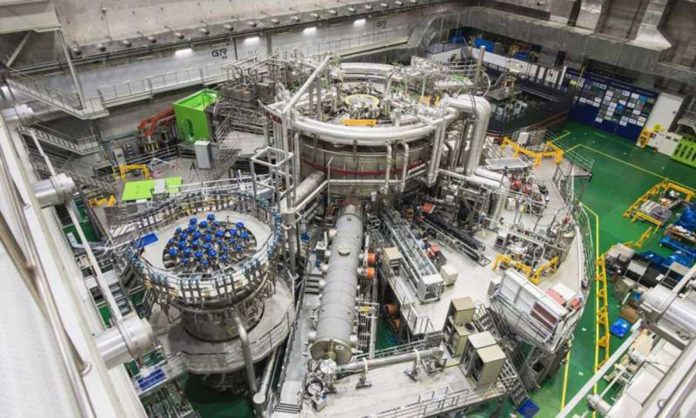In its 2020 experiment, The Korea Superconducting Tokamak Advanced Research (KSTAR), a superconducting fusion device known as the Korean artificial sun, sets a new world record of 20-sec-long operation 100 million degrees. The artificial sun has successfully maintained high-temperature plasma for 20 seconds with an ion temperature of over 100 million degrees (Celsius).
In collaboration with the Seoul National University (SNU) and Columbia University of the United States, KSTAR Research Center at the Korea Institute of Fusion Energy (KFE) succeeded in the continuous operation of plasma for 20 seconds with an ion-temperature higher than 100 million degrees, which is one of the core conditions of nuclear fusion in the 2020 KSTAR Plasma Campaign.
In 2019, the artificial sun succeeded in maintaining 8 second plasma operation time. In 2018, the KSTAR reached the plasma ion temperature of 100 million degrees for the first time (retention time: about 1.5 seconds).
There have been other fusion devices that have overseen plasma at temperatures of 100 million degrees or higher until now. None of them broke the limits of maintaining the activity for 10 seconds or more. It is the operational limit of a normal-conducting device. It wasn’t easy to maintain a stable plasma state in the fusion device at such high temperatures for a long time.
In its 2020 experiment, the KSTAR improved the performance of the Internal Transport Barrier (ITB) mode, one of the next generation plasma operation modes developed last year, and succeeded in maintaining the plasma state for an extended period, overcoming the existing limits of the ultra-high-temperature plasma operation.
Director Si-Woo Yoon of the KSTAR Research Center at the KFE explained, “The technologies required for long operations of 100 million- plasma are the key to the realization of fusion energy, and the KSTAR’s success in maintaining the high-temperature plasma for 20 seconds will be an important turning point in the race for securing the technologies for the long high-performance plasma operation, a critical component of a commercial nuclear fusion reactor in the future.”
Yong-Su Na, professor at the Department of Nuclear Engineering, SNU, who has been jointly researching the KSTAR plasma operation, said, “The success of the KSTAR experiment in the long, high-temperature operation by overcoming some drawbacks of the ITB modes brings us a step closer to the development of technologies for the realization of nuclear fusion energy.”
Dr. Young-Seok Park of Columbia University, who contributed to creating the high-temperature plasma, said: “We are honored to be involved in such an important achievement made in KSTAR. The 100 million-degree ion temperature achieved by enabling efficient core plasma heating for such a long duration demonstrated the superconducting KSTAR device’s unique capability. It will be acknowledged as a compelling basis for high performance, steady-state fusion plasmas.”
The KSTAR will share its key experiment outcomes in 2020, including this success with fusion researchers across the world in the IAEA Fusion Energy Conference which will be held in May.
